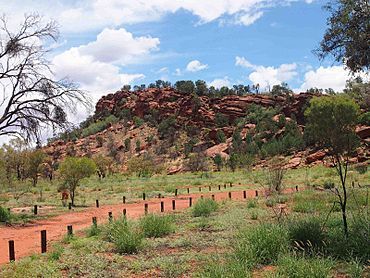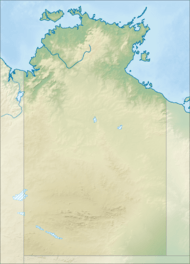Native Gap Conservation Reserve facts for kids
Quick facts for kids Native Gap Conservation ReserveNorthern Territory |
|
|---|---|
|
IUCN Category V (Protected Landscape/Seascape)
|
|

Sandstone Ridge at Native gap
|
|
| Established | 26 May 1980 |
| Area | 11 hectares (27 acres) |
| Managing authorities | Parks and Wildlife Commission of the Northern Territory |
| See also | Protected areas of the Northern Territory |
Native Gap Conservation Reserve is a special protected area in Australia's Northern Territory. It was set up on May 26, 1980, to protect its unique nature and cultural importance. This reserve covers about 11 hectares (27 acres) of land.
It is a very important place for the traditional owners, the Arrernte and Anmatyerr peoples. They consider it a sacred site. The reserve gets its name from a tall sandstone ridge that stands out in the area.
Contents
Finding Native Gap Reserve
This reserve is located in the heart of Australia. It is about 115 kilometers (71 miles) north of Alice Springs. You can also find it about 1,380 kilometers (857 miles) south of Darwin.
The reserve is just off the Stuart Highway. You take an unsealed track (a dirt road) to reach it. This track leads towards a telecommunications tower in the nearby Hann Range.
A Place of Ancient Stories
Native Gap is very important to the traditional owners, the Arrernte and Anmatyerr peoples. For them, it is a sacred site. Many creation stories meet at this spot.
The Arrernte name for the site is Arurlte Artwatye. Arurlte means 'the top of the shoulders across the neck'. Artwatye means 'gap'. This name describes the sandstone ridge that looks like a gap in the land.
How the Name Came to Be
The name "Native Gap" was first used in 1872. This was when workers were building the Overland Telegraph. A builder named W. W. Mills told Charles Todd they had found a "Native Gap."
Mills wrote about a "native well" in a gap in Hann's Range. People believe the gap was named after this important water source. Later, in 1880, telegraph workers used explosives to widen the gap. Sadly, this destroyed the rocks that held water.
Amazing Plants of the Reserve
Native Gap Conservation Reserve is home to many interesting plants. The tall sandstone ridge has special trees like the native fig and white cypress pine. You can also find shrubs such as Acacia monticola and Acacia melleodora.
Even in exposed areas, Eucalyptus gamophylla and Eucalyptus sessilis grow on the ridge. On the sandy flats, you will see ironwood, desert bloodwood, and ghost gums.
The reserve also has desert grasses and spinifex. After it rains, you might spot Drosera plants on the flats. Other plants include Grevillea wickhamii and some types of Gossypium.
Wildlife at Native Gap
The reserve is a great place for animals, especially birds. You can see western bowerbirds eating the native figs. Little woodswallows fly around, and dusky grasswrens hide in the spinifex. After wet seasons, brown quail can be found.
Other birds include the whistling kite, rainbow bee-eater, and willie wagtail. You might also spot an inland thornbill, variegated fairywren, mistletoebird, grey-headed honeyeater, and Torresian crow.
Besides birds, the reserve is home to mammals. These include the short-beaked echidna, the euro (a type of wallaroo), and the black-footed rock-wallaby.


